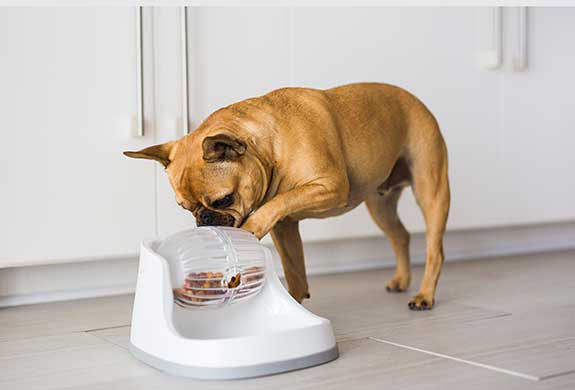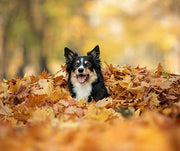Ways to Prevent Messy Eating

There's nothing more frustrating than your recently cleaned kitchen floor turning into a pigpen when it's your dog's mealtime. Dogs are bound to make messes every now and again, but what should you do when your dog constantly makes a mess while eating?
First, it's helpful to figure out why your dog is a messy eater. There can be several factors that contribute to sloppy eating, and some of them may be completely out of your – or your dog's – control.
Some days may be predisposed to being messy eaters due to their facial structure. Brachycephalic breeds, such as pugs or bulldogs, have flatter faces which can contribute to messy eating. They may have trouble keeping food in their mouth while chewing.
There are also medical conditions that can cause your dog to have trouble eating. A few examples are oral cancers, oral ulceration, megaesophagus, or even facial injuries. Gum disease and dental issues can contribute to your pup being a messy eater as well. This is why it is important to stay up to date on visits to the vet and to stay on top of cleaning your dog's teeth regularly.
Sometimes, messy eating can be a behavioral issue. Maybe your dog often attempts to bring his food to a different room of the house before nibbling at it. Maybe he likes to play with his food, resulting in more ending up on the floor than in his mouth. Or maybe he tends to eat too fast. Whatever the case, bring up any concerns you have with a veterinarian. They can help you get to the bottom of the behavior.
HOW TO PREVENT FOOD MESSES
Once you've figured out the reason why your dog is a messy eater, it's time to find a solution! If your dog has a specific medical condition or disorder, you may need to discuss some next steps with your vet to find a solution that works. Whatever the reason for the mess, though, some of these options can also help keep things a little tidier during dinnertime.
1. NON-SKID BOWLS
The type of dog bowl that you serve your dog's food in can make all the difference when it comes to the messiness of mealtime! Some bowls slide around while others may be more prone to tipping over, especially if your dog is excited. Non-skid bowls, like JW's Skid Stop Basic Bowl, have rubber bases that keeps the bowl from sliding across your floor, preventing food and water from spilling out. If you're having trouble finding a non-skid bowl, heavy bowls will do the trick as well since they are harder to slide around and tip over.
2. PLACEMATS
If you thought placemats are only for decorating the table, you're wrong! Dog placemats are the perfect option for those who want to keep their floor clean. Plus, they come in a variety of size and material options so you can find something that works perfectly for your home.

3. SLOW FEEDERS
If messiness is largely due to your dog eating too fast, a slow feeder might be a good solution to the problem. There are many different types of slow feeders available, and each of them works to slow your pet's eating down. Some just let out a little bit of food at a time, while others have "obstacles" that force your dog to slow down and eat more intentionally. For example, Petmate's Diggin' Diner (shown below) is a slower feeder that your dog has to paw at in order for the food to dispense. As your dog paws at the spinning bowl, small portions of food dispense giving your dog a little at a time to eat. Another thing you can do is place an object such as a tennis ball in the middle of your dog's dry food. This will force them to focus on eating around it, helping them focus on eating rather than scarfing all of their food down at once.

3. TREAT TOYS
Treat toys are another good option for dogs that tend to eat too fast. Like slow feeders, they make your dog work a little harder for their food. They can also be a great way to keep your dog distracted and entertained.
4. FEEDING IN THEIR CRATE
If you're tired of cleaning your floor repeatedly, it may be time to try feeding your dog in their crate. This will help keep any mess they make limited to one spot. You may still need to wipe down their crate after mealtime, but it can be a better alternative to mopping your entire kitchen. If the weather is nice, you also may want to consider feeding your dog outside.
5. SMALLER PORTIONS
Last of all, feeding your dog smaller portions of food more often throughout the day can be another way to help them slow down while eating and prevent messes. Dogs who are fed smaller portions throughout the day will less likely be hungry, meaning they will be less excited and less likely to spill their food everywhere.
CONCLUSION
Messy eating can certainly be a nuisance, but there are many creative things you can do to fix this issue. Be sure you address any concerns with your vet and remember to have patience as you work with your dog to keep your floors clean.
Sources:
Previous article

Next article

Related posts
View all-

How to Keep Your Pet Calm During Thanksgiving
Thanksgiving is a time for family, friends, and food, but for our pets, the holiday can be overwhelming. The sudden change in routine, unfamiliar faces and scents, and increased noise can trigger significant stress. Understanding why your pet might feel anxious is the first step toward creating a peaceful holiday experience for everyone, including your furry family members. This guide offers calming tips for pets and practical solutions to ensure your dog or cat feels safe and secure during the festivities.
Read Article -

Top Travel Essentials for Pets This Holiday Season
Holiday travel often means bringing the whole family along, and for many of us, that includes our furry companions. Preparing for holiday pet travel is about more than just packing a bag; it's about ensuring your pet's safety, comfort, and happiness from the moment you leave home until you return. A little planning helps reduce stress for both you and your pet, making the journey a positive experience for everyone involved.
Read Article -

Best Leashes and Collars for Daily Walks: A Pet Parent’s Guide
A daily walk with your dog isn't just a chore—it's a chance to bond, explore, and stay active together. The right leash and collar can make every walk safer and more enjoyable for both of you. With numerous styles and materials available, it's essential to find gear that suits your dog's needs and your lifestyle.
Read Article



